Spatiotemporal Variability of Land Surface Albedo over the Tibet Plateau from 2001 to 2019
Abstract
1. Introduction
2. Study Area and Datasets
2.1. Study Area
2.2. Datasets and Pre-processing
2.2.1. Remote Sensing Products
2.2.2. ERA-Interim Reanalysis Products
3. Statistical Methods
3.1. Trend Analysis
3.2. Radiative Forcing Calculation
4. Results
4.1. Spatial and Seasonal Variation of Land Surface Albedo
4.2. Albedo Anomaly and the Interrelation with Ecological-Meteorological Parameters
4.3. Albedo Variation Following the Change of Mean Slope, Aspect, and Land Covers
4.4. The Radiative Forcing Shifts Due to the Albedo Variation over the Topographic Terrain
5. Discussion
6. Conclusions
Author Contributions
Funding
Acknowledgments
Conflicts of Interest
References
- Bonan, G.B. Forests and Climate Change: Forcings, Feedbacks, and the Climate Benefits of Forests. Nature 2008, 320, 1444–1449. [Google Scholar] [CrossRef] [PubMed]
- Kiehl, J.T.; Hack, J.J.; Bonan, G.B.; Boville, B.A.; Briegleb, B.P.; Williamson, D.L.; Rasch, P.J. Description of the Ncar Community Climate Model (ccm3). Available online: https://www.osti.gov/biblio/442361 (accessed on 13 February 2020).
- Anderson, R.G.; Canadell, J.G.; Randerson, J.T.; Jackson, R.B.; Hungate, B.A.; Baldocchi, D.D.; Ban-Weiss, G.A.; Bonan, G.B.; Caldeira, K.; Cao, L. Biophysical considerations in forestry for climate protection. Front. Ecol. Environ. 2011, 9, 174–182. [Google Scholar] [CrossRef]
- Bala, G.; Caldeira, K.; Wickett, M.; Phillips, T.J.; Lobell, D.B.; Delire, C.; Mirin, A. Combined climate and carbon-cycle effects of large-scale deforestation. Proc. Natl. Acad. Sci. USA 2007, 104, 6550–6555. [Google Scholar] [CrossRef] [PubMed]
- Planque, C.; Carrer, D.; Roujean, J.-L. Analysis of MODIS albedo changes over steady woody covers in France during the period of 2001–2013. Remote Sens. Environ. 2017, 191, 13–29. [Google Scholar] [CrossRef]
- Bauer, S.E.; Menon, S. Aerosol direct, indirect, semidirect, and surface albedo effects from sector contributions based on the IPCC AR5 emissions for preindustrial and present-day conditions. J. Geophys. Res. Atmos. 2012, 117–130. [Google Scholar] [CrossRef]
- Bonan, G.B. Effects of land use on the climate of the United States. J. Clim. Chang. 1997, 37, 449–486. [Google Scholar] [CrossRef]
- Pimentel, R.; Aguilar, C.; Herrero, J.; Pérezpalazón, M.J.; Polo, M.J. Comparison between Snow Albedo Obtained from Landsat TM, ETM+ Imagery and the SPOT VEGETATION Albedo Product in a Mediterranean Mountainous Site. Hydrology 2016, 3, 10. [Google Scholar] [CrossRef]
- Jiao, T.; Williams, C.A.; Ghimire, B.; Masek, J.; Gao, F.; Schaaf, C. Global Climate Forcing from Albedo Change Caused by Large-scale Deforestation and Reforestation: Quantification and Attribution of Geographic Variation. Clim. Chang. 2017, 142, 463–476. [Google Scholar] [CrossRef]
- Cess, R.D. Biosphere-Albedo Feedback and Climate Modeling. J. Atmos. Sci. 1978, 35, 1765–1768. [Google Scholar] [CrossRef]
- Van de Kerchove, R.; Lhermitte, S.; Veraverbeke, S.; Goossens, R. Spatio-temporal variability in remotely sensed land surface temperature, and its relationship with physiographic variables in the Russian Altay; Mountains. Int. J. Appl. Earth Obs. 2013, 20, 4–19. [Google Scholar] [CrossRef]
- Ollinger, S.V.; Richardson, A.D.; Martin, M.E.; Hollinger, D.Y.; Frolking, S.E.; Reich, P.B.; Plourde, L.C.; Katul, G.G.; Munger, J.W.; Oren, R. Canopy nitrogen, carbon assimilation, and albedo in temperate and boreal forests: Functional relations and potential climate feedbacks. Proc. Natl. Acad. Sci. USA 2008, 105, 19336. [Google Scholar] [CrossRef] [PubMed]
- Lucht, W.; Hyman, A.H.; Strahler, A.H.; Barnsley, M.J.; Hobson, P.; Muller, J.P. A comparison of satellite-derived spectral albedos to ground-based broadband albedo measurements modeled to satellite spatial scale for a semidesert landscape. Remote Sens. Environ. 2000, 74, 85–98. [Google Scholar] [CrossRef]
- Schaaf, C.B.; Gao, F.; Strahler, A.H.; Lucht, W.; Li, X.W.; Tsang, T.; Strugnell, N.C.; Zhang, X.Y.; Jin, Y.F.; Muller, J.P.; et al. First operational BRDF, albedo nadir reflectance products from MODIS. Remote Sens. Environ. 2002, 83, 135–148. [Google Scholar] [CrossRef]
- Strahler, A.H.; Muller, J.; Lucht, W.; Schaaf, C.; Tsang, T.; Gao, F.; Li, X.; Lewis, P.; Barnsley, M.J. MODIS BRDF/albedo product: Algorithm theoretical basis document version 5.0. MODIS Doc. 1999, 23, 42–47. [Google Scholar]
- Liu, Q.; Wang, L.Z.; Qu, Y.; Liu, N.F.; Liu, S.H.; Tang, H.R.; Liang, S.L. Preliminary evaluation of the long-term GLASS albedo product. Int. J. Digit. Earth 2013, 6, 69–95. [Google Scholar] [CrossRef]
- Liang, S.; Zhao, X.; Liu, S.; Yuan, W.; Cheng, X.; Xiao, Z.; Zhang, X.; Liu, Q.; Cheng, J.; Tang, H.; et al. A long-term Global LAnd Surface Satellite (GLASS) data-set for environmental studies. Int. J. Digit. Earth 2013, 6, 5–33. [Google Scholar] [CrossRef]
- Muller, J.-P.; López, G.; Watson, G.; Shane, N.; Kennedy, T.; Yuen, P.; Lewis, P.; Fischer, J.; Guanter, L.; Domench, C. The ESA GlobAlbedo Project for Mapping the Earth’s Land Surface Albedo for 15 Years from European Sensors. Available online: https://www.semanticscholar.org/paper/The-ESA-GlobAlbedo-Project-for-mapping-the-Earth%27s-Muller-Lopez/5c67e348414afec872360c8d1d5063a57a1ab722 (accessed on 13 February 2020).
- Folkert Boersma, K.; Muller, J.P. Quality Assurance for Essential Climate Variables. In Proceedings of the Egu General Assembly Conference, Vienna, Austria, 23–28 April 2017. [Google Scholar]
- Cescatti, A.; Marcolla, B.; Vannan, S.K.S.; Pan, J.Y.; Román, M.O.; Yang, X.; Ciais, P.; Cook, R.B.; Law, B.E.; Matteucci, G. Intercomparison of MODIS albedo retrievals and in situ measurements across the global FLUXNET network. Remote Sens. Environ. 2012, 121, 323–334. [Google Scholar] [CrossRef]
- Mira, M.; Weiss, M.; Baret, F.; Courault, D.; Hagolle, O.; Gallego-Elvira, B.; Olioso, A. The MODIS (collection V006) BRDF/albedo product MCD43D: Temporal course evaluated over agricultural landscape. Remote Sens. Environ. 2015, 170, 216–228. [Google Scholar] [CrossRef]
- Wang, Z.; Schaaf, C.B.; Sun, Q.; Shuai, Y.; Román, M.O. Capturing rapid land surface dynamics with Collection V006 MODIS BRDF/NBAR/Albedo (MCD43) products. Remote Sens. Environ. 2018, 207, 50–64. [Google Scholar] [CrossRef]
- He, T.; Liang, S.; Song, D.X. Analysis of global land surface albedo climatology and spatial-temporal variation during 1981–2010 from multiple satellite products. J. Geophys. Res. Atmos. 2014, 119, 10281–10298. [Google Scholar] [CrossRef]
- Loranty, M.M.; Berner, L.T.; Goetz, S.J.; Jin, Y.; Randerson, J.T. Vegetation controls on northern high latitude snow-albedo feedback: Observations and CMIP5 model simulations. Glob. Chang. Biol. 2014, 20, 594–606. [Google Scholar] [CrossRef] [PubMed]
- Shekhar, M.; Chand, H.; Kumar, S.; Srinivasan, K.; Ganju, A. Climate-change studies in the western Himalaya. Ann. Glaciol. 2010, 51, 105–112. [Google Scholar] [CrossRef]
- Verheijen, F.G.A.; Jeffery, S.; van der Velde, M.; Penízek, V.; Beland, M.; Bastos, A.C.; Keizer, J.J. Reductions in soil surface albedo as a function of biochar application rate: Implications for global radiative forcing. Environ. Res. Lett. 2013, 8, 4008. [Google Scholar] [CrossRef]
- Ghimire, B.; Williams, C.A.; Masek, J.; Feng, G.; Wang, Z.; Schaaf, C.; Tao, H. Global albedo change and radiative cooling from anthropogenic land-cover change, 1700 to 2005 based on MODIS, land-use harmonization, radiative kernels and reanalysis. Geophys. Res. Lett. 2014, 41, 9087–9096. [Google Scholar] [CrossRef]
- Mortimer, C.A.; Sharp, M. Spatiotemporal variability of Canadian High Arctic glacier surface albedo from MODIS data, 2001–2016. Cryosphere 2018, 12, 701–720. [Google Scholar] [CrossRef]
- Fang, H.; Liang, S.; Kim, H.Y.; Townshend, J.R.; Schaaf, C.L.; Strahler, A.H.; Dickinson, R.E. Developing a spatially continuous 1 km surface albedo data set over North America from Terra MODIS products. J. Geophys. Res. Atmos. 2007, 112, 1–20. [Google Scholar] [CrossRef]
- Shi, Q.; Liang, S. Characterizing the surface radiation budget over the Tibetan Plateau with ground-measured, reanalysis, and remote sensing data sets: 2. Spatiotemporal analysis: SRB OF THE TIBETAN PLATEAU, 2. J. Geophys. Res. Atmos. 2013, 118, 8921–8934. [Google Scholar] [CrossRef]
- Shine, K.P. Radiative Forcing of Climate Change. Weather 2002, 57, 278–283. [Google Scholar]
- Beniston, M. Climatic Change in Mountain Regions: A Review of Possible Impacts. Clim. Chang. 2003, 59, 5–31. [Google Scholar] [CrossRef]
- Ma, Y.; Fan, S.; Ishikawa, H.; Tsukamoto, O.; Yao, T.; Koike, T.; Zuo, H.; Hu, Z.; Su, Z. Diurnal and inter-monthly variation of land surface heat fluxes over the central Tibetan Plateau area. Theor. Appl. Climatol. 2005, 80, 259–273. [Google Scholar] [CrossRef]
- Shen, M.; Piao, S.; Jeong, S.-J.; Zhou, L.; Zeng, Z.; Ciais, P.; Chen, D.; Huang, M.; Jin, C.-S.; Li, L.Z.X.; et al. Evaporative cooling over the Tibetan Plateau induced by vegetation growth. Proc. Natl. Acad. Sci. USA 2015, 112, 9299–9304. [Google Scholar] [CrossRef] [PubMed]
- Tian, L.; Zhang, Y.; Zhu, J. Decreased surface albedo driven by denser vegetation on the Tibetan Plateau. Environ. Res. Lett. 2014, 9, 104001. [Google Scholar] [CrossRef]
- Yao, T.; Xue, Y.; Chen, D.; Chen, F.; Thompson, L.; Cui, P.; Koike, T.; Lau, W.K.-M.; Lettenmaier, D.; Mosbrugger, V.; et al. Recent Third Pole’s Rapid Warming Accompanies Cryospheric Melt and Water Cycle Intensification and Interactions between Monsoon and Environment: Multidisciplinary Approach with Observations, Modeling, and Analysis. Bull. Am. Meteorol. Soc. 2019, 100, 423–444. [Google Scholar] [CrossRef]
- Wen, J.; Liu, Q.; Xiao, Q.; Liu, Q.; You, D.; Hao, D.; Wu, S.; Lin, X. Characterizing Land Surface Anisotropic Reflectance over Rugged Terrain: A Review of Concepts and Recent Developments. Remote Sens. 2018, 10, 370. [Google Scholar] [CrossRef]
- Zheng, L.; Zhao, G.; Dong, J.; Ge, Q.; Tao, J.; Zhang, X.; Qi, Y.; Doughty, R.B.; Xiao, X. Spatial, temporal, and spectral variations in albedo due to vegetation changes in China’s grasslands. ISPRS J. Photogramm. Remote Sens. 2019, 152, 1–12. [Google Scholar] [CrossRef]
- Scherler, D.; Bookhagen, B.; Strecker, M.R. Spatially variable response of Himalayan glaciers to climate change affected by debris cover. Nat. Geosci. 2011, 4, 156. [Google Scholar] [CrossRef]
- Xie, X. A Climatic Estimation of Surface Albedo in Summer and the Distribution of Albedo over the Qinghai-Xizang Plateau; American Meteorological Society: Boston, MA, USA; pp. 162–169.
- Guo, X.; Yang, K.; Long, Z.; Wei, Y.; Li, S.; Zhu, M.; Yao, T.; Chen, Y. Critical Evaluation of Scalar Roughness Length Parametrizations Over a Melting Valley Glacier. Bound. Layer Meteorol. 2011, 139, 307–332. [Google Scholar] [CrossRef]
- Yang, W.; Guo, X.; Yao, T.; Yang, K.; Zhao, L.; Li, S.; Zhu, M. Summertime surface energy budget and ablation modeling in the ablation zone of a maritime Tibetan glacier. J. Geophys. Res. Atmos. 2011, 116, 1–11. [Google Scholar] [CrossRef]
- Balsamo, G.; Albergel, C.; Beljaars, A.; Boussetta, S.; Brun, E.; Cloke, H.; Dee, D.; Dutra, E.; Munoz-Sabater, J.; Papenberger, F. ERA-Interim/Land: A global land surface reanalysis dataset. Hydrol. Earth Syst. Sci. 2015, 19, 389–407. [Google Scholar] [CrossRef]
- Bao, X.; Zhang, F. Evaluation of NCEP-CFSR, NCEP-NCAR, ERA-Interim, and ERA-40 reanalysis datasets against independent sounding observations over the Tibetan Plateau. J. Clim. 2013, 26, 206–214. [Google Scholar] [CrossRef]
- Dee, D.P.; Uppala, S.M.; Simmons, A.; Berrisford, P.; Poli, P.; Kobayashi, S.; Andrae, U.; Balmaseda, M.; Balsamo, G.; Bauer, D.P. The ERA-Interim reanalysis: Configuration and performance of the data assimilation system. Q. J. R. Meteorol. Soc. 2011, 137, 553–597. [Google Scholar] [CrossRef]
- Cui, X.; Graf, H.F. Recent land cover changes on the Tibetan Plateau: A review. Clim. Chang. 2009, 94, 47–61. [Google Scholar] [CrossRef]
- Tanaka, K.; Tamagawa, I.; Ishikawa, H.; Ma, Y.; Hu, Z. Surface energy budget and closure of the eastern Tibetan Plateau during the GAME-Tibet IOP 1998. J. Hydrol. 2003, 283, 169–183. [Google Scholar] [CrossRef]
- Coll, C.; Caselles, V.; Galve, J.M.; Valor, E.; Niclòs, R.; Sánchez, J.M.; Rivas, R. Ground measurements for the validation of land surface temperatures derived from AATSR and MODIS data. Remote Sens. Environ. 2005, 97, 288–300. [Google Scholar] [CrossRef]
- Wan, Z. New refinements and validation of the MODIS Land-Surface Temperature/Emissivity products. Remote Sens. Environ. 2008, 112, 59–74. [Google Scholar] [CrossRef]
- Fensholt, R.; Sandholt, I.; Rasmussen, M.S. Evaluation of MODIS LAI, fAPAR and the relation between fAPAR and NDVI in a semi-arid environment using in situ measurements. Remote Sens. Environ. 2004, 91, 490–507. [Google Scholar] [CrossRef]
- Sulla-Menashe, D.; Friedl, M.A. User Guide to Collection 6 MODIS Land Cover (MCD12Q1 and MCD12C1) Product; USGS: Reston, VA, USA, 2018.
- Stroeve, J.C.; Box, J.E.; Haran, T. Evaluation of the MODIS (MOD10A1) daily snow albedo product over the Greenland ice sheet. Remote Sens. Environ. 2006, 105, 155–171. [Google Scholar] [CrossRef]
- Wu, S.; Wen, J.; You, D.; Zhang, H.; Xiao, Q.; Liu, Q. Algorithms for Calculating Topographic Parameters and Their Uncertainties in Downward Surface Solar Radiation (DSSR) Estimation. IEEE Geosci. Remote Sens. Lett. 2018, 15, 1149–1153. [Google Scholar] [CrossRef]
- Berrisford, P.; Dee, D.P.; Fielding, K.; Fuentes, M.; Kållberg, P.W.; Kobayashi, S.; Uppala, S.M. The ERA-interim archive. ERA Rep. 2009, 1, 1–16. [Google Scholar]
- Ramaswamy, V.; Boucher, O.; Haigh, J.; Hauglustine, D.; Haywood, J.; Myhre, G.; Nakajima, T.; Shi, G.; Solomon, S. Radiative forcing of climate. Clim. Chang. 2001, 349–416. [Google Scholar]
- Muñoz, I.; Campra, P.; Fernández-Alba, A.R. Including CO2-emission equivalence of changes in land surface albedo in life cycle assessment. Methodology and case study on greenhouse agriculture. Int. J. Life Cycle Assess. 2010, 15, 672–681. [Google Scholar] [CrossRef]
- Lenton, T.M.; Vaughan, N.E. Physics. The radiative forcing potential of different climate geoengineering options. Atmos. Chem. 2009, 9, 5539–5561. [Google Scholar] [CrossRef]
- Li, Z.; He, Y.; An, W.; Song, L.; Zhang, W.; Catto, N.; Wang, Y.; Wang, S.; Liu, H.; Cao, W. Climate and glacier change in southwestern China during the past several decades. Environ. Res. Lett. 2011, 6, 045404. [Google Scholar] [CrossRef]
- Rangwala, I.; Miller, J.R.; Ming, X. Warming in the Tibetan Plateau: Possible influences of the changes in surface water vapor. Geophys. Res. Lett. 2009, 36, 295–311. [Google Scholar] [CrossRef]
- Dimri, A.P.; Kumar, D.; Choudhary, A.; Maharana, P. Future changes over the Himalayas: Mean temperature. Glob. Planet. Chang. 2018, 162, 212–234. [Google Scholar] [CrossRef]
- Betts, R.A. Offset of the potential carbon sink from boreal forestation by decreases in surface albedo. Nature 2000, 408, 187–190. [Google Scholar] [CrossRef]
- Chen, C.; Park, T.; Wang, X.; Piao, S.; Xu, B.; Chaturvedi, R.K.; Fuchs, R.; Brovkin, V.; Ciais, P.; Fensholt, R.; et al. China and India lead in greening of the world through land-use management. Nat. Sustain. 2019, 2, 122–129. [Google Scholar] [CrossRef]
- Jian, P.; Liu, Z.; Liu, Y.; Wu, J.; Han, Y. Trend analysis of vegetation dynamics in Qinghai–Tibet Plateau using Hurst Exponent. Ecol. Indic. 2012, 14, 28–39. [Google Scholar]
- Yi, S.; Long, J.; Wang, H. Vegetation Changes along the Qinghai-Tibet Plateau Engineering Corridor Since 2000 Induced by Climate Change and Human Activities. Remote Sens. 2018, 10, 95. [Google Scholar]
- Deng, H.; Pepin, N.C.; Liu, Q.; Chen, Y. Understanding the spatial differences in terrestrial water storage variations in the Tibetan Plateau from 2002 to 2016. Clim. Chang. 2018, 151, 379–393. [Google Scholar] [CrossRef]
- Andrews, T.; Forster, P.M.; Gregory, J.M. A surface energy perspective on climate change. J. Clim. 2009, 22, 2557. [Google Scholar] [CrossRef]
- Zhai, J.; Liu, R.; Liu, J.; Zhao, G.; Huang, L. Radiative forcing over China due to albedo change caused by land cover change during 1990–2010. Acta Geogr. Sin. 2014, 24, 789–801. [Google Scholar] [CrossRef]
- Mahmood, R.; Pielke, R.A., Sr.; Hubbard, K.G.; Niyogi, D.; Bonan, G.; Lawrence, P.; Mcnider, R.; Mcalpine, C.; Etter, A.; Gameda, S. Impacts of land use/land cover change on climate and future research priorities. Bull. Am. Meteorol. Soc. 2010, 91, 37–46. [Google Scholar] [CrossRef]
- Pielke, R.A. Land Use and Climate Change. Science 2005, 310, 1625–1626. [Google Scholar] [CrossRef] [PubMed]
- Manabe, S.; Broccoli, A.J. Mountains and Arid Climates of Middle Latitudes. Sci. China Earth Sci. 1990, 247, 192–195. [Google Scholar] [CrossRef]
- Ye, D.Z.; Wu, G.X. The role of the heat source of the Tibetan Plateau in the general circulation. Meteorol. Atmos. Phys. 1998, 67, 181–198. [Google Scholar] [CrossRef]
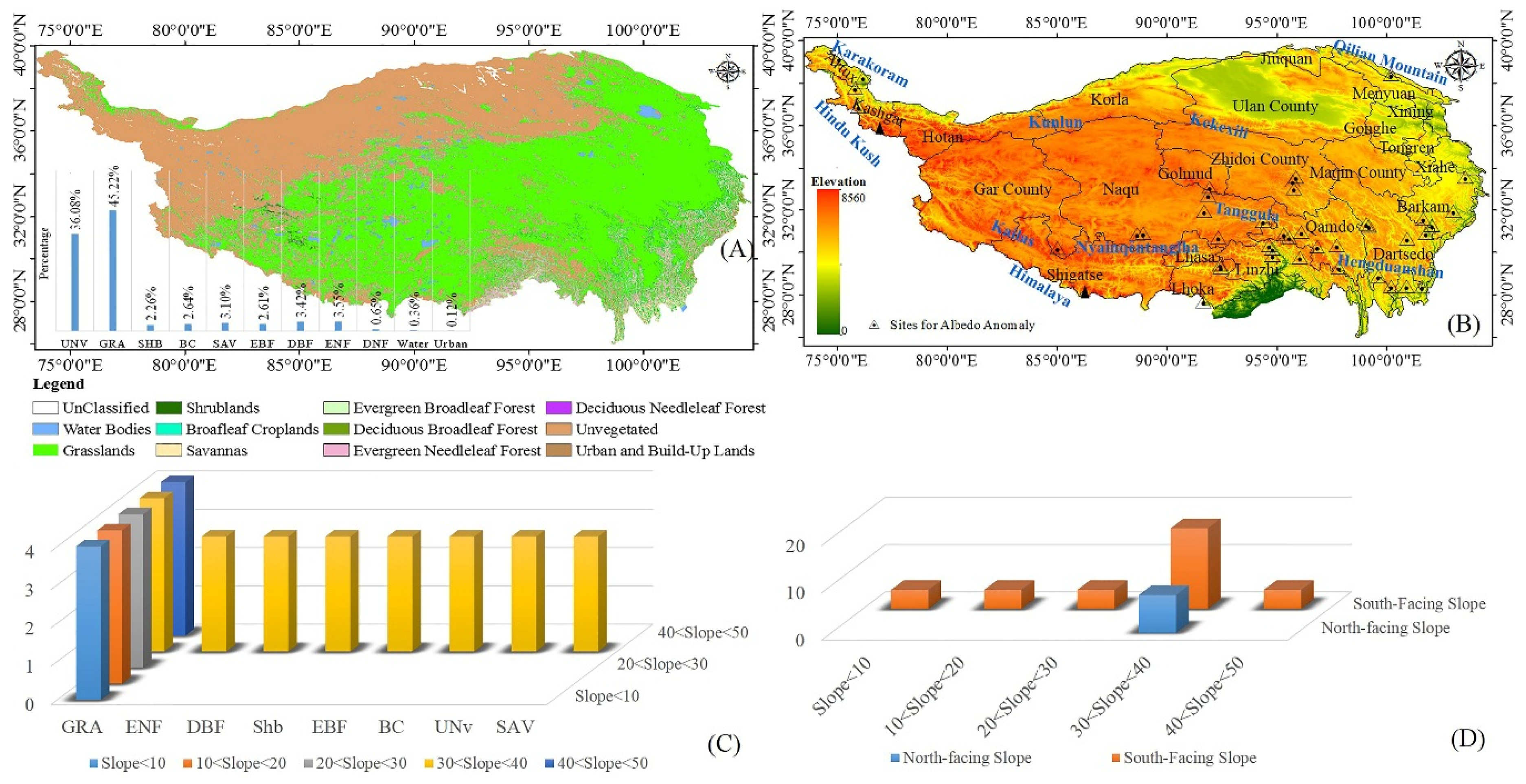

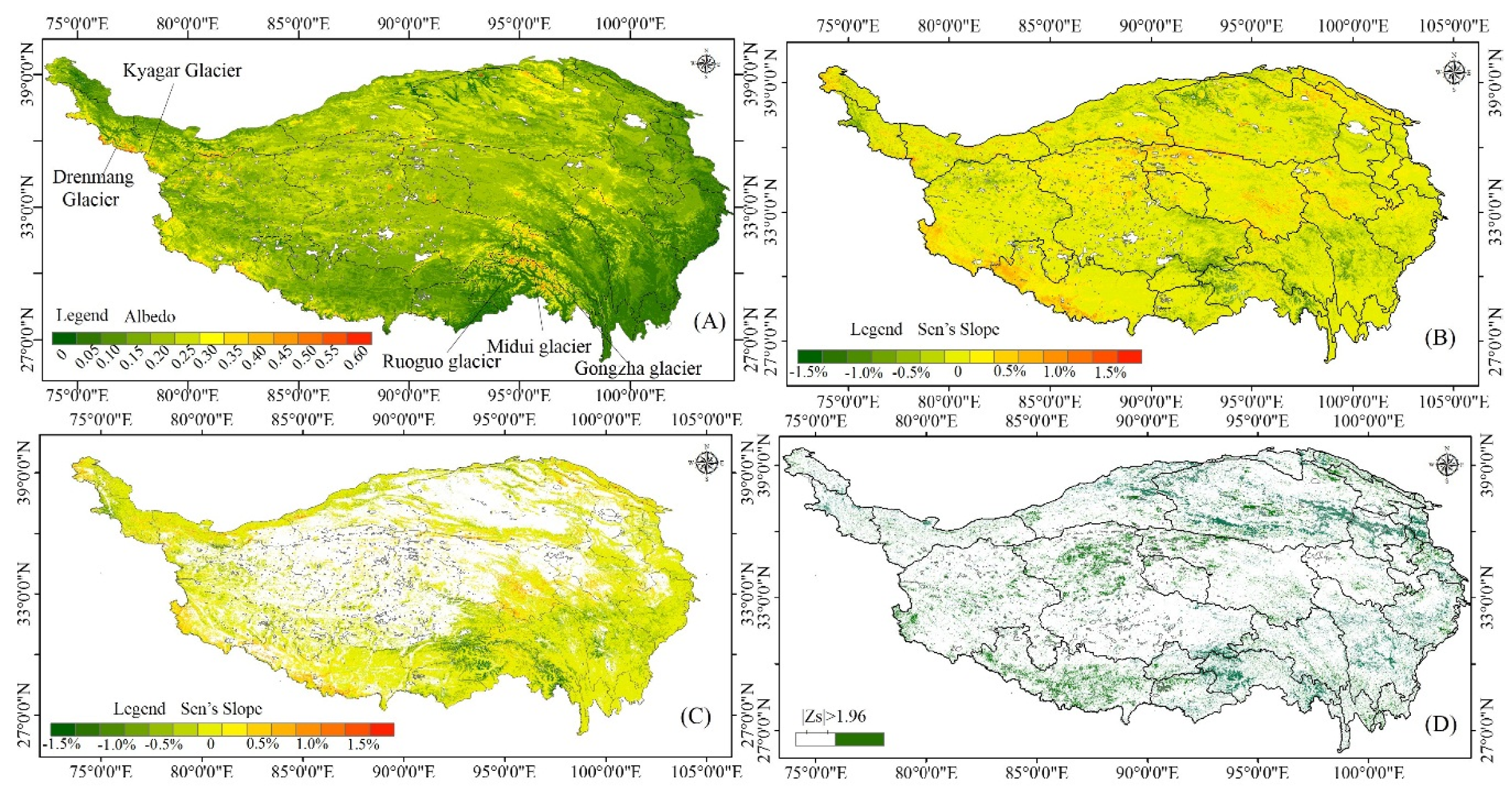

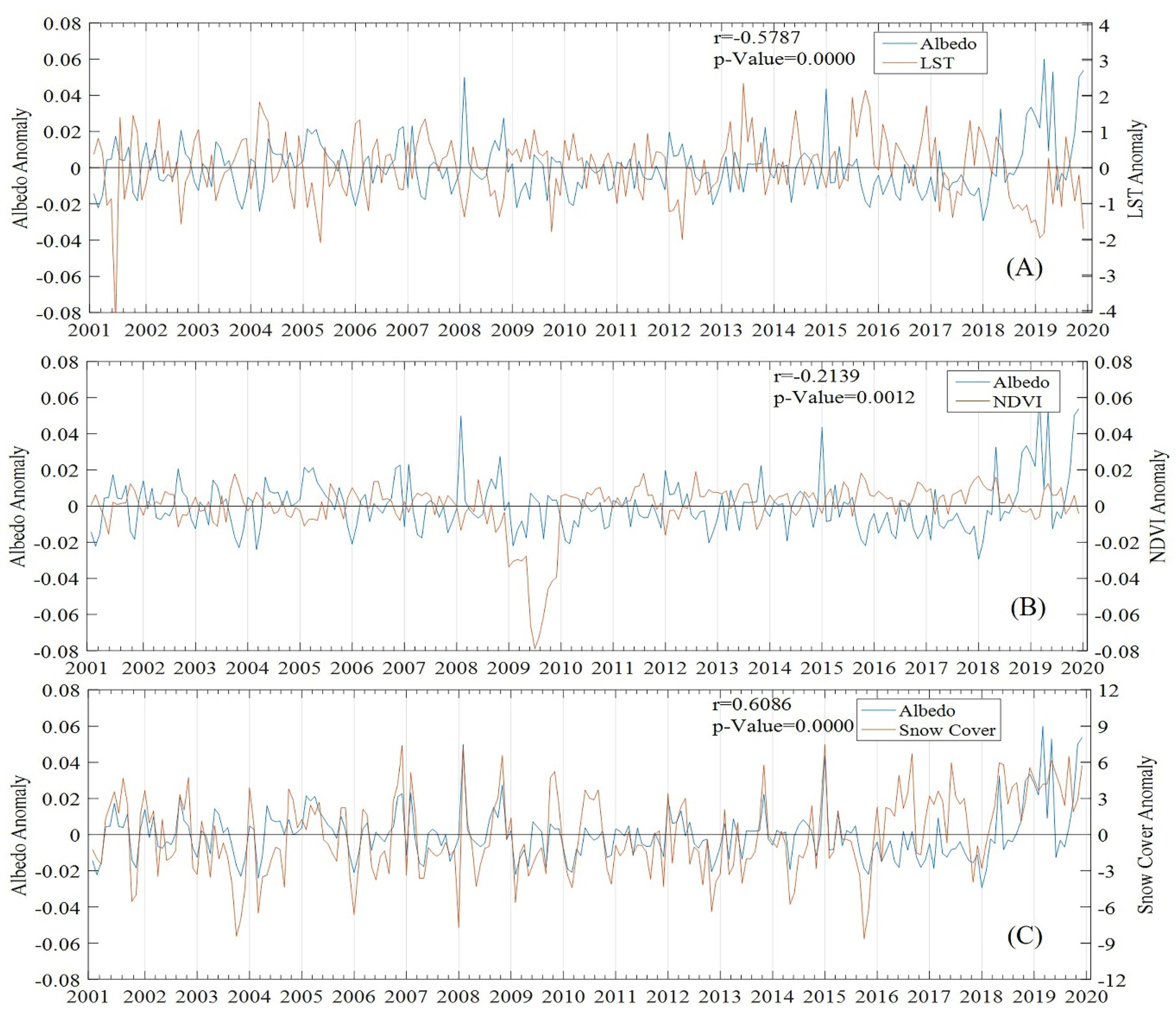


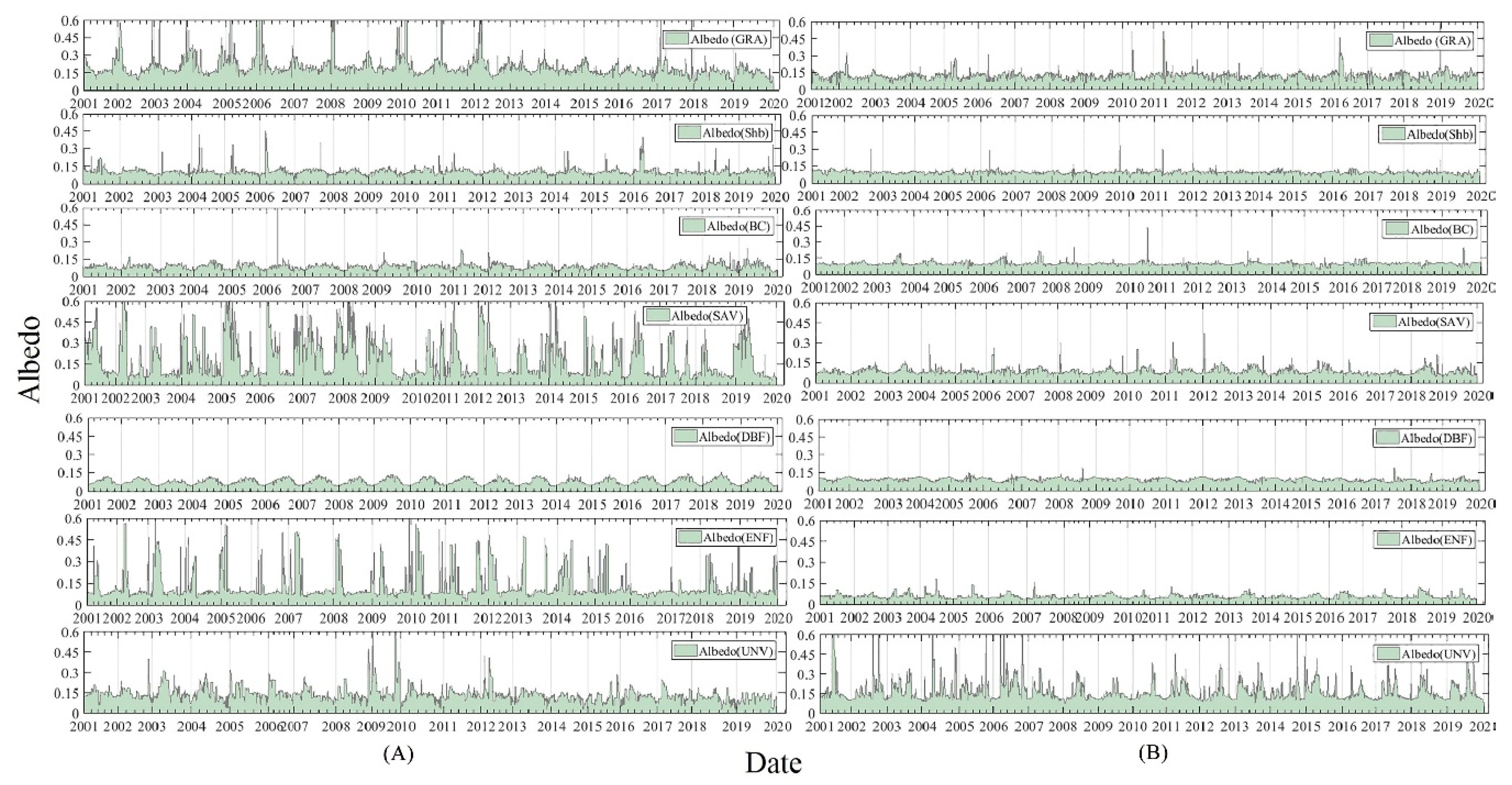
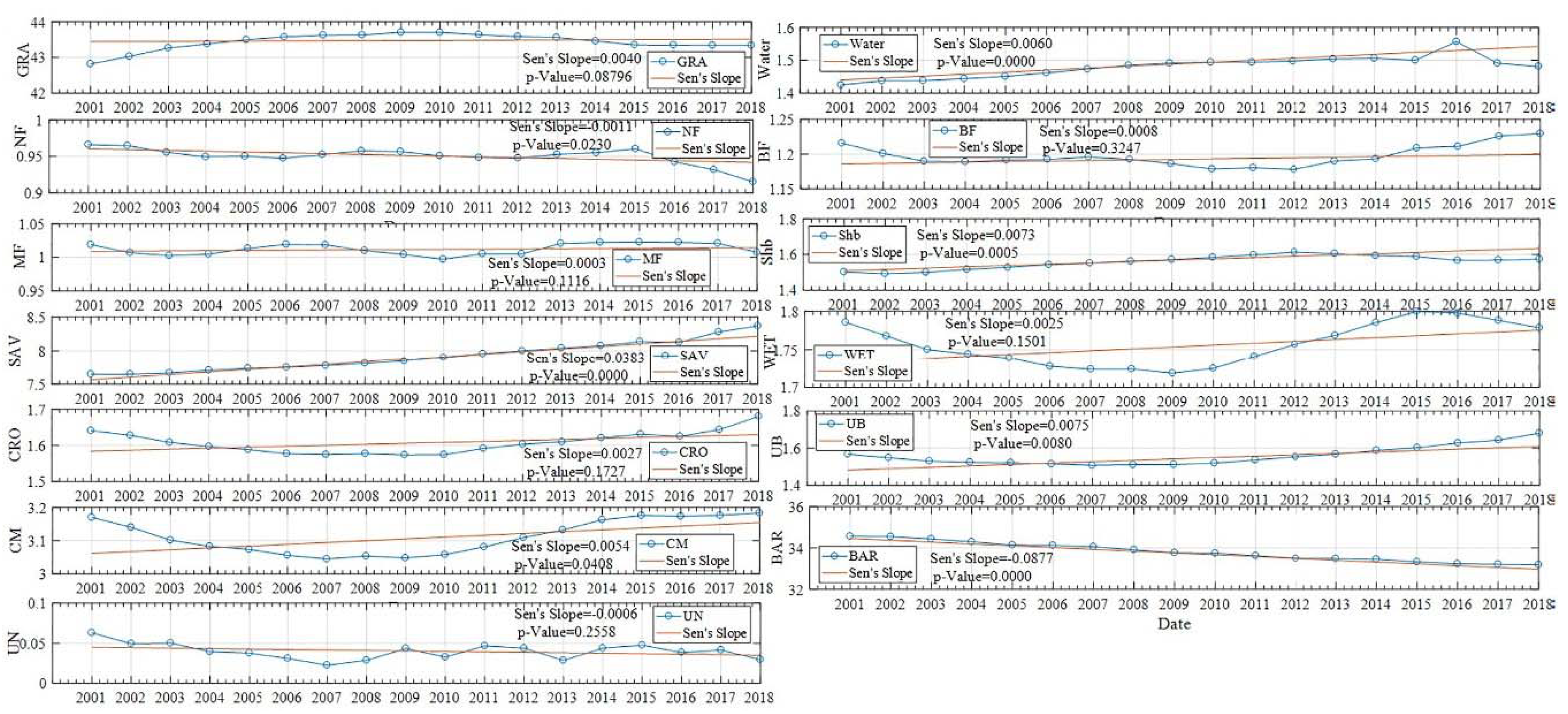
| Parameter | Dataset | Spatial Resolution | Temporal Resolution |
|---|---|---|---|
| Albedo | MCD43A3 | 500 m | Daily |
| Normalized difference vegetation index (NDVI) | MOD13A1 | 500 m | 16-day |
| Land surface temperature (LST) | MOD11A1 | 1000 m | Daily |
| Land Cover Type | MCD12Q1 | 500 m | Yearly |
| The fraction of snow cover | MOD10A1 | 500 m | Daily |
| Top of Atmosphere (TOA) incident solar radiation | ERA-Interim | 0.125° | Daily |
| Downward solar radiation | ERA -Interim | 0.125° | Daily |
| Land Cover | Delta BSA | Delta WSA | Affected Area | RF BSA (W·m−2) | RF WSA (W·m−2) | RRF BSA (W·m−2) | RRF WSA (W·m−2) |
|---|---|---|---|---|---|---|---|
| GRA | −0.0040 | −0.0038 | 3.67% | 0.4639 | 0.4408 | 0.0170 | 0.0162 |
| Shb | −0.0028 | −0.0030 | 0.24% | 0.3227 | 0.3495 | 0.0008 | 0.0008 |
| BC | −0.0037 | −0.0038 | 0.26% | 0.4262 | 0.4329 | 0.0011 | 0.0011 |
| SAV | −0.0030 | −0.0031 | 0.27% | 0.3466 | 0.3594 | 0.0009 | 0.0010 |
| EBF | −0.0031 | −0.0030 | 0.21% | 0.3618 | 0.3411 | 0.0008 | 0.0007 |
| DBF | −0.0024 | −0.0025 | 0.24% | 0.2781 | 0.2869 | 0.0007 | 0.0007 |
| ENF | −0.0022 | −0.0020 | 0.24% | 0.2499 | 0.2296 | 0.0006 | 0.0005 |
| DNF | −0.0019 | −0.0022 | 0.32% | 0.2183 | 0.2500 | 0.0007 | 0.0008 |
| UNV | −0.0019 | −0.0020 | 4.61% | 0.2140 | 0.2343 | 0.0099 | 0.0108 |
| Land Cover | LCC | AreaLCC | BSA* | WSA* | Delta BSA* | Delta WSA* | RF BSA | RF WSA | RRF BSA | RRF WSA |
|---|---|---|---|---|---|---|---|---|---|---|
| Barren and Soil | SAV | 1.74% | 0.1716 | 0.1815 | −0.0108 | −0.0112 | 1.2448 | 1.2909 | 0.0217 | 0.0225 |
| Shb | 0.47% | 0.1388 | 0.1474 | −0.0069 | −0.0080 | 0.7953 | 0.9220 | 0.0037 | 0.0043 | |
| WAT | 0.29% | 0.0591 | 0.0621 | −0.0440 | −0.0460 | 5.0712 | 5.3017 | 0.0147 | 0.0154 | |
| Other | 0.44% | 0.1540 | 0.1628 | −0.0114 | −0.0112 | 1.3139 | 1.2909 | 0.0243 | 0.0239 |
© 2020 by the authors. Licensee MDPI, Basel, Switzerland. This article is an open access article distributed under the terms and conditions of the Creative Commons Attribution (CC BY) license (http://creativecommons.org/licenses/by/4.0/).
Share and Cite
Lin, X.; Wen, J.; Liu, Q.; You, D.; Wu, S.; Hao, D.; Xiao, Q.; Zhang, Z.; Zhang, Z. Spatiotemporal Variability of Land Surface Albedo over the Tibet Plateau from 2001 to 2019. Remote Sens. 2020, 12, 1188. https://doi.org/10.3390/rs12071188
Lin X, Wen J, Liu Q, You D, Wu S, Hao D, Xiao Q, Zhang Z, Zhang Z. Spatiotemporal Variability of Land Surface Albedo over the Tibet Plateau from 2001 to 2019. Remote Sensing. 2020; 12(7):1188. https://doi.org/10.3390/rs12071188
Chicago/Turabian StyleLin, Xingwen, Jianguang Wen, Qinhuo Liu, Dongqin You, Shengbiao Wu, Dalei Hao, Qing Xiao, Zhaoyang Zhang, and Zhenzhen Zhang. 2020. "Spatiotemporal Variability of Land Surface Albedo over the Tibet Plateau from 2001 to 2019" Remote Sensing 12, no. 7: 1188. https://doi.org/10.3390/rs12071188
APA StyleLin, X., Wen, J., Liu, Q., You, D., Wu, S., Hao, D., Xiao, Q., Zhang, Z., & Zhang, Z. (2020). Spatiotemporal Variability of Land Surface Albedo over the Tibet Plateau from 2001 to 2019. Remote Sensing, 12(7), 1188. https://doi.org/10.3390/rs12071188








